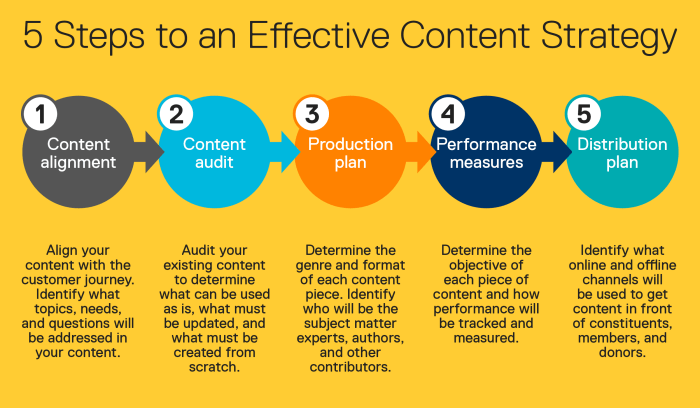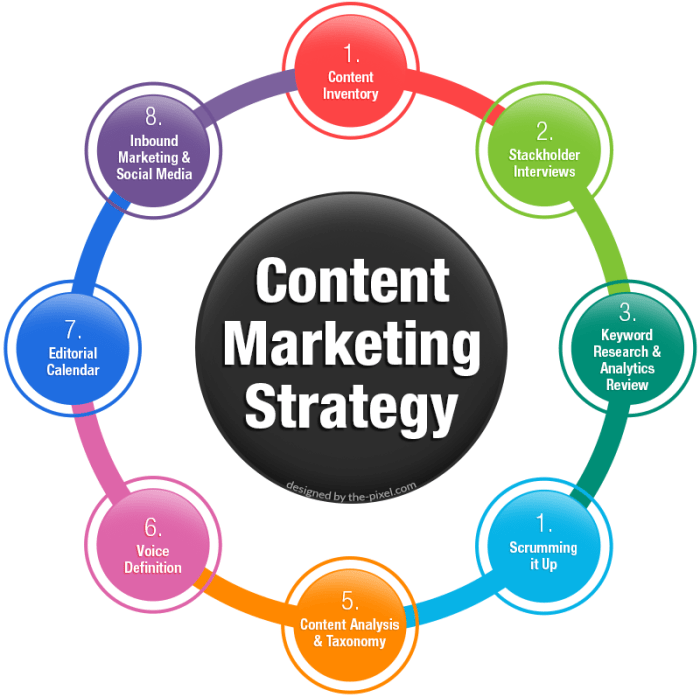Content Marketing Strategy sets the stage for success in the digital realm, unlocking the secrets behind effective brand storytelling and audience engagement.
From defining the strategy to measuring success, this guide will take you on a journey through the core elements of a winning content plan.
Overview of Content Marketing Strategy

Content marketing strategy is a plan to create and distribute valuable, relevant content to attract and engage a target audience. It involves using content like blogs, videos, social media posts, and more to drive profitable customer action.
Having a well-defined content marketing strategy is crucial for businesses to stand out in a crowded digital landscape. It helps build brand awareness, establish expertise, and nurture relationships with customers. A solid strategy also guides content creation, distribution, and measurement, ensuring that efforts are focused and effective.
Examples of Successful Companies
- Red Bull: Known for its high-energy content like extreme sports videos and events, Red Bull has successfully built a lifestyle brand through engaging content marketing.
- HubSpot: The marketing software company provides valuable resources like blogs, webinars, and guides to educate its audience and attract leads, showcasing the power of inbound marketing.
- Coca-Cola: With its “Share a Coke” campaign and user-generated content contests, Coca-Cola has effectively used storytelling and interactive content to connect with consumers on a personal level.
Elements of a Content Marketing Strategy
Content marketing strategy is crucial for reaching and engaging your target audience. Here are some key elements that make up a successful content marketing strategy:
Identifying the Target Audience
To create content that resonates with your audience, it’s essential to identify who they are. This involves researching demographics, interests, and behaviors to understand what they need and want from your brand. By defining your target audience, you can tailor your content to address their specific pain points and provide valuable solutions.
Role of Storytelling
Storytelling plays a vital role in content marketing strategy as it helps create a connection with your audience on an emotional level. By sharing compelling stories, you can humanize your brand, build trust, and engage your audience in a meaningful way. Storytelling allows you to communicate your brand’s values, mission, and unique selling proposition in a way that resonates with your target audience.
Content Creation and Distribution

Content creation and distribution are crucial aspects of a successful content marketing strategy. By creating engaging and valuable content and distributing it effectively, businesses can reach their target audience and drive conversions. Let’s explore the different types of content that can be created, best practices for creating engaging content, and the importance of distributing content through various channels.
Types of Content
- Blog Posts: Informative articles that provide value to the audience and establish the business as an authority in the industry.
- Infographics: Visual representations of data or information that are easy to consume and share on social media.
- Videos: Engaging and entertaining videos that can be shared on websites, social media platforms, and video hosting sites like YouTube.
- Case Studies: In-depth analysis of how a product or service solved a specific problem for a customer, showcasing real-life success stories.
Best Practices for Creating Engaging Content
- Know Your Audience: Understand the needs, preferences, and pain points of your target audience to create content that resonates with them.
- Use Compelling Headlines: Capture the audience’s attention with catchy headlines that pique their curiosity and encourage them to click.
- Include Visuals: Incorporate images, videos, and infographics to make your content more visually appealing and engaging.
- Provide Value: Offer valuable information, insights, or solutions that address the audience’s problems or interests.
Importance of Distributing Content Through Various Channels
- Reach a Wider Audience: By distributing content through multiple channels such as social media, email, and , businesses can reach a larger and more diverse audience.
- Increase Brand Visibility: Consistent distribution of content across different channels helps increase brand awareness and visibility in the market.
- Drive Traffic and Conversions: Distributing content through various channels drives traffic to the website, increases lead generation, and ultimately boosts conversions and sales.
Measuring Success of a Content Marketing Strategy
When it comes to measuring the success of a content marketing strategy, it’s essential to identify key performance indicators (KPIs) that align with your overall goals. These KPIs will help you track the effectiveness of your content efforts and make informed decisions to optimize your strategy.
Key Performance Indicators (KPIs)
- Website Traffic: Monitoring the number of visitors to your website can indicate the reach and engagement of your content.
- Conversion Rate: Tracking the percentage of visitors who take a desired action, such as making a purchase or signing up for a newsletter, can show the effectiveness of your content in driving conversions.
- Engagement Metrics: Analyzing metrics like time spent on page, bounce rate, and social shares can provide insights into how well your content resonates with your audience.
Tools and Methods for Tracking
- Google Analytics: This tool helps track website traffic, user behavior, and conversions, providing valuable data for measuring content performance.
- Social Media Insights: Platforms like Facebook, Twitter, and LinkedIn offer analytics tools to monitor engagement metrics and audience demographics.
- Content Management Systems: Platforms like HubSpot, WordPress, and Drupal provide built-in analytics to track content performance and audience behavior.
Analyzing Data to Optimize Strategy, Content Marketing Strategy
By analyzing data from KPIs and tracking tools, you can identify trends, strengths, and weaknesses in your content strategy. This data-driven approach allows you to make informed decisions to optimize your content for better results.












